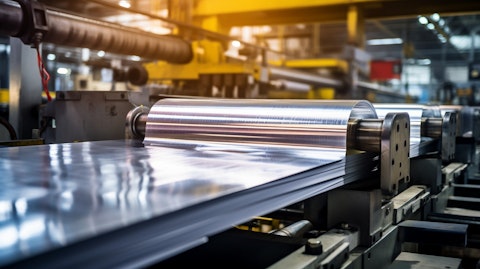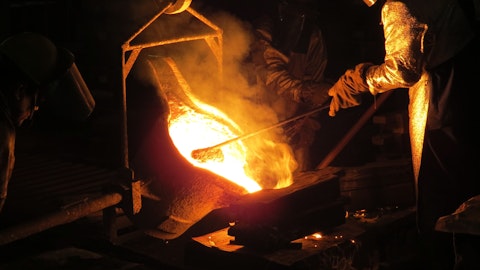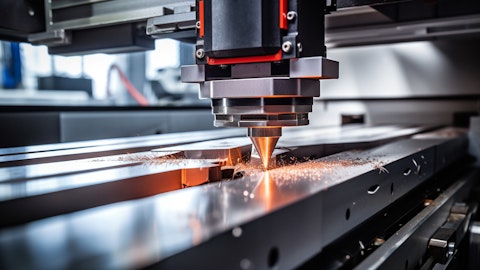Constellium SE (NYSE:CSTM) Q4 2023 Earnings Call Transcript February 21, 2024
Constellium SE misses on earnings expectations. Reported EPS is $0.07 EPS, expectations were $0.31. CSTM isn’t one of the 30 most popular stocks among hedge funds at the end of the third quarter (see the details here).
Operator: Hello, and welcome to the Constellium Fourth Quarter and Full-Year 2023. My name is Elliot, and I’ll be coordinating your call today. [Operator Instructions] I would now like to hand over to Jason Hershiser, Director of Investor Relations. The floor is yours. Please go ahead.
Jason Hershiser: Thank you, Elliot. I would like to welcome everyone to our fourth quarter and full-year 2023 earnings call. On the call today, we have our Chief Executive Officer, Jean-Marc Germain; and our Chief Financial Officer, Jack Guo. After the presentation, we will have a Q&A session. A copy of the slide presentation for today’s call is available on our website at constellium.com, and today’s call is being recorded. Before we begin, I’d like to encourage everyone to visit the Company’s website and take a look at our recent filings. Today’s call may include forward-looking statements within the meaning of the Private Securities Litigation Reform Act of 1995. Such statements include statements regarding the Company’s anticipated financial and operating performance, future events and expectations and may involve known and unknown risks and uncertainties.
For a summary of specific risk factors that could cause results to differ materially from those expressed in the forward-looking statements, please refer to the factors presented under the heading Risk Factors in our Annual Report on Form 20-F. All information in this presentation is as of the date of the presentation. We undertake no obligation to update or revise any forward-looking statement as a result of new information, future events or otherwise, except as required by law. In addition, today’s presentation includes information regarding certain non-GAAP financial measures. Please see the reconciliations of non-GAAP financial measures attached in today’s slide presentation, which supplement our IFRS disclosures. I would now like to hand the call over to Jean-Marc.
Jean-Marc Germain: Thank you, Jason, and good morning, good afternoon, everyone. Thank you for your interest in Constellium. Let’s begin on Slide 5. I want to start by thanking each of our 12,000 employees for their commitment and relentless focus on safety, our number one priority. Our recordable case rate this year of 1.95 per million hours worked was slightly higher than last year, but I am pleased to report that we continue to deliver best-in-class safety performance. Our safety journey is never complete, and we all need to remain focused on this critical priority every day. We remain fully committed to achieving our safety target to reduce our recordable case rate to 1.5 by 2025. Now let’s turn to Slide 6 and discuss the highlights from our fourth quarter performance.
Shipments were 336,000 tons, down 9% and compared to the fourth quarter of 2022 due to lower shipments in each of our segments. Revenue of €1.6 billion decreased 13% compared to last year as improved price and mix was more than offset by lower shipments and lower metal prices. Remember, while our revenues are affected by changes in metal prices, we operate a pass-through business model, which minimizes our exposure to metal price risk. Our value-added revenue, which reflects our sales, excluding the cost of metal was €681 million, down 2% compared to the same period last year. Our net income of €11 million in the quarter compares to net income of €30 million in the fourth quarter of last year. As you can see in the bridge on the top right, adjusted EBITDA was €171 million in the quarter, up 15% compared to last year and in line with our prior guidance.
Also, we extended our track record of consistent free cash flow generation with €58 million in the quarter. The combination of pricing power, improved mix and solid execution by our team drove strong results in the quarter, which Jack will discuss later in more detail. Now turn to Slide 7 for the full-year highlights. For the full-year, shipments were 1.5 million tons or down 6% compared to 2022. Revenue of €7.2 billion was down 11% as improved price and mix in each of our segments was more than offset by lower shipments and lower metal prices. Our net income of €129 million compared to net income of €308 million in 2022. As a reminder, last year included €154 million related to the recognition of deferred tax assets that were previously unrecognized.
Adjusted EBITDA was €713 million or up 6% compared to last year. This performance is a record for the company and a record for our A&T segment. We delivered our fifth consecutive year of positive free cash flow with a total of €170 million in 2023. We achieved adjusted return on invested capital of 11.3% in 2023, which is up 30 basis points compared to last year. As you can see on the bottom right of the slide, we finished 2023 with leverage of 2.3x or down half a term from the end of 2022. Overall, I am very proud of our fourth quarter and full-year 2023 performance. We demonstrated our pricing power, again, by delivering record adjusted EBITDA and strong free cash flow in 2023. I am also pleased to announce today that our Board has authorized a share repurchase program of up to $300 million that expires in December 2026.
We expect to begin the program in the first half of this year. Now that were within our target leverage range, returning capital to our shareholders is an important part of our strategy moving forward, and we believe it will help drive shareholder value creation. We look forward to updating you on our progress each quarter. With that, I will now hand the call over to Jack for further details on our financial performance.
Jack Guo: Thank you, Jean-Marc, and thank you, everyone for joining the call today. Please turn now to Slide 9. Value-added revenue was €681 million in the fourth quarter of 2023, down 2% compared to the same quarter last year. Looking at the fourth quarter, volume was a headwind of €44 million due to lower shipments in each of our segments. Price and mix was a tailwind of €73 million compared to the same period last year, while metal impacts were a headwind of €10 million. The balance of the change was largely due to the sale of our German extrusion business and unfavorable FX translation. For the full-year 2023, the VAR drivers were similar. There are two important [takeaways] from this slide. First, for the full-year 2023, we grew our value-added revenue by 7% compared to 2022.
And second, we continue to have pricing power. Price and mix and price specifically continues to be the biggest increment of our year-over-year variance and helped us offset significant inflationary pressures. Now turn to Slide 10. And let’s focus on our P&ARP segment performance. Adjusted EBITDA of €82 million increased 16% compared to the fourth quarter last year. Volume was a headwind of €10 million with higher shipments in automotive, more than offset by lower shipments in packaging and specialty rolled products. Automotive shipments increased 2% in the quarter despite some impact from the UAW strike early in the quarter. Packaging shipments decreased 8% in the quarter versus last year. Within packaging, canstock shipments were up slightly in the quarter versus last year, but more than offset by lower shipments of specialty packaging in Europe.
Price and mix was a tailwind of €21 million, primarily on improved contract pricing, including inflation-related pass-throughs. Costs were a tailwind of €2 million as favorable metal costs, inflation energy-related government grants more than offset higher operating costs in the period. FX translation, which is non-cash, was a headwind of €2 million in the quarter. For the full-year 2023, P&ARP generated adjusted EBITDA of €283 million, a decrease of 13% compared to 2022. The drivers of the full-year performance were similar to those in the fourth quarter with the exception of costs, which were a headwind of €158 million, including all favorable metal costs, operating challenges at our Muscle Shoals facility and significant inflationary pressures faced earlier in the period.
Now turn to Slide 11, and let’s focus on the A&T segment. Adjusted EBITDA of €76 million increased 36% compared to the fourth quarter last year. Volume was a headwind of €13 million as higher aerospace shipments were more than offset by lower TID shipments in the quarter. Aerospace shipments were up around 10% versus last year as the recovery in aerospace markets continues. Shipments in TID were down 19% versus last year, reflecting a slowdown in most industrial markets. Price and mix was a tailwind of €48 million on improved contract pricing, including inflation-related pass-throughs and a stronger mix with more aerospace. Costs were a headwind of €17 million, primarily as a result of higher operating costs. FX and other was a tailwind of €2 billion in the quarter.
For the full-year 2023, A&T generated record adjusted EBITDA of €324 million, an increase of 50% compared to 2022. The drivers of the full-year performance were similar to those in the fourth quarter. Now I’ll turn to Slide 12, and let’s focus on the AS&I segment. Adjusted EBITDA of €25 million decreased 22% compared to the fourth quarter last year. Volume was a €6 million headwind as a result of lower shipments in industry. Automotive shipments were stable in the quarter versus last year despite some impact from the UAW strike early in the quarter, the timing impact between certain program switches and the sale of our German extrusion business. Industry shipments were down 33% in the quarter versus last year as a result of weaker market conditions in Europe and the sale of our German extrusion business.
Price and mix was a €3 million tailwind primarily due to improved contract pricing, including inflation-related pass-throughs. Costs were a headwind of €1 million on lower operating costs more than offset by inflation. FX and other was a headwind of €2 million in the quarter. For the full-year 2023, AS&I generated adjusted EBITDA of €133 million, a decrease of 11% compared to 2022. The drivers of the full-year performance were similar to those in the fourth quarter. It is not on the slide here, but I wanted to conclude with some quick comments on Holdings and Corporate. For the full-year 2023, our holdings and corporate expense was €2.7 million. We currently expect holdings and corporate expense to run at approximately €40 million in 2024 with the increase primarily driven by additional IT spending with the upgrade of our ERP system.
Now turn to Slide 13, where I want to give an update on the current inflationary environment we are facing and our focus on pricing and cost control to offset these pressures. Throughout most of 2023, we were faced with broad-based and significant inflationary pressures, although the pressure began to – in some categories in the fourth quarter. As you know, we operate a pass-through business model, so we are not materially exposed to changes in the market price of aluminum, our largest cost input. Labor and other nonmetal costs continue to be higher. For energy, our 2024 energy costs are largely secured and at moderately more favorable levels compared to 2023, although energy prices remain well above historical averages. Given these cost pressures, we continue to work across a number of fronts to mitigate their impact on our results.

We have demonstrated strong cost performance in the past years, and we will continue our relentless focus. As we previously noted, many of our existing contracts have inflationary protection mechanisms and where they do not, we are working with our customers to include them. As you have seen our results, we have demonstrated very good progress across all of our end markets. As you can see in the bridge on the right, we were very successful again in 2023 with price and mix, the largest increment being priced in offsetting inflationary cost pressures and demand headwinds. We expect inflationary pressures in some categories to continue in 2024, but at more moderated levels. We are confident in our ability to offset a substantial portion of the impact with an improved topline this year and our relentless focus on cost control.
Now let’s turn to Slide 14 and discuss our free cash flow. We generated strong free cash flow of €170 million in 2023, including €58 million in the fourth quarter. As you can see on the bottom left of the slide, we have continued to deliver our commitment to generate consistent, strong free cash flow. Since the beginning of 2019, we have generated €820 million of free cash flow. Looking at 2024, we expect to generate free cash flow in excess of €130 million for the full-year, though we expect this to be negative in the first quarter and weighted more towards the second half of the year, similar to last year given the seasonality in our business. We expect CapEx to be around €370 million this year, which includes higher spending on return-seeking projects, such as our recycling and casting center in Neuf-Brisach.
The facility is expected to start up on time and on budget in the fourth quarter this year. We expect cash interest of approximately €125 million, which includes the impact from higher interest rates. We expect cash taxes of approximately €55 million. Lastly, we expect working capital and other to be a modest use of cash for the full-year. With the expected free cash flow generation of over €130 million, we intend to use a large portion of the free cash flow to begin repurchasing shares starting in the first half of the year, as Jean-Marc mentioned. We have the ability to begin limited share repurchases in the near-term without shareholder approval. To fully execute the size of the program, we announced today we will rely on shareholder approval each year at our Annual General Meeting, including the one in the second quarter this year.
Now let’s turn to Slide 15 and discuss our balance sheet and liquidity position. At the end of the fourth quarter, our net debt of €1.7 billion was down over €220 million compared to the end of 2022. Our leverage reached a multiyear low of 2.3x at the end of 2023 were down 0.5x versus the end of 2022 and within our target leverage range. We remain committed to maintaining our target leverage range of 1.5 to 2.5x. As you can see in our debt summary, we have no bond maturities until 2026 and our liquidity remains strong at €373 million as of the end of 2023. We are extremely proud of the progress we have made on our capital structure and of the financial flexibility we’ve built, including the ability to begin returning capital to our shareholders.
Before turning the call back to Jean-Marc, I wanted to spend a minute on Slide 16 to discuss changes to the presentation of certain non-GAAP financial measures. The changes are based on discussions we had with the staff of the SEC and specifically related to the adjustment for metal price lag, which is non-cash in certain non-GAAP financial measures. The changes will be reflected when we report our first quarter 2024 results. For the first change, moving forward, we will no longer be reporting our value-added revenue. For the second change, we will be revising our definition of adjusted EBITDA to no longer exclude the non-cash impact of metal price lag, which the staff considers to be inconsistent with the guidance in question 100.04 of the compliance and disclosure interpretations on non-GAAP financial measures.
While the going-forward disclosure of consolidated adjusted EBITDA will no longer remove metal price lag, we will continue to exclude metal price lag from our segment adjusted EBITDA, which we use for evaluating the performance of our operating segments. And as a reminder, consolidated adjusted EBITDA following the revision, less metal price lag is equal to consolidated adjusted EBITDA prior to the revision. We will continue to provide investors and other stakeholders with all the information necessary to understand the non-cash impact of metal price lag on our reported results each quarter. For comparability, we have provided tables on Slide 17 and 18 to show a reconciliation of prior period adjusted EBITDA under the old definition to the new definition.
Moving to adjusted EBITDA guidance. The company will continue to provide guidance excluding metal price lag. In addition, leverage as defined by the company will continue to be calculated as net debt divided by adjusted EBITDA, excluding metal price lag. I hope that’s all clear. With that, I would now like to hand the call back to Jean-Marc.
Jean-Marc Germain: Thank you, Jack. Let’s turn to Slide 20 and discuss our current end market outlook. The majority of our portfolio today is serving end markets currently benefiting from durable sustainability-driven secular growth, in which aluminum, a light and infinitely recyclable material plays a critical role. Turning first to packaging. Canstock inventory adjustments appear largely behind us in both North America and Europe. Canstock demand has stabilized in recent quarters, though demand is still relatively low given the current inflationary environment, the lack of promotional activity and following a multiyear period of rapid growth during COVID. Even in today’s environment, aluminum cans continue to outperform and win share against other substrates like plastics and glass.
The long-term outlook for this end market continues to be favorable as evidenced by the growing consumer preference for the sustainable aluminum beverage cans, capacity growth plans, broadcast makers in both regions and the greenfield investments ongoing here in North America. We are expecting growth to return in canstock in 2024. And longer term, we continue to expect packaging markets to grow low to mid-single digits in both North America and Europe. We’ll participate in this growth in both regions as announced at our Analyst Day two years ago. I am pleased to report that the recycling and casting center we are building at our Neuf-Brisach facility is well underway and both on time and on budget, as Jack mentioned. At Muscle Shoals, operational performance continued to improve during the fourth quarter.
Last month, though, the extreme cold weather and the snow impacted operations and shipments for a full week. The plant is in the process of ramping back up now, though, this will have an impact on our first quarter results. Turning now to automotive. Auto OEM sales and production numbers globally have increased the last couple of years, but remained below pre-COVID levels. Demand decelerated in the second half of 2023, although it remains healthy. Our automotive business was up slightly in the fourth quarter despite some impact early in the quarter from the UAW strike in North America. Consumer demand for luxury cars, light trucks and SUVs remains steady. Vehicle electrification and sustainability trends will continue to drive the demand for lightweighting and use of aluminum products in the long-term.
As a result, we remain very positive on this market. Let’s turn now to aerospace. The recovery in aerospace continued in the quarter, though demand remains below pre-COVID levels. Major aero OEMs remain focused on increasing build rates for both narrow and wide-body aircraft. We remain confident that the long-term fundamentals driving aerospace demand remain intact, including growing passenger traffic and greater demand for new, more fuel-efficient aircraft. Demand remains strong in the business and regional jet markets and the defense and space markets. In addition, we continue to experience strong demand for our Airware family of products. As a chart on the left side of the page highlights, these three core end markets represented 79% of our revenue in 2023.
Turning lastly to other specialties. We expect weakness to continue in most industrial markets, and in general, these markets are dependent on the health of the industrial economies in each region. In TID rolled products and industry extrusions, demand is generally weak today. We do expect some recovery in these markets as we move through the year. In summary, we like the fundamentals in each of the markets we serve and strongly believe that the diversification of our end markets is an asset for the company. Let’s turn now to Slide 21, where we detail our key messages and financial guidance. Our team achieved very strong performance in 2023, including record adjusted EBITDA of €713 million and strong free cash flow of €170 million. Importantly, we also further deleveraged our balance sheet to a multiyear low of 2.3x, and we are now within our target leverage range.
I’m very proud of our performance, especially in this challenging environment. As we look ahead, while uncertainties persist on the macroeconomic and geopolitical fronts, we are optimistic about our prospects for 2024 and beyond. Based on our current outlook, for 2024, we are targeting adjusted EBITDA, excluding the non-cash impact of metal price lag, as Jack commented, in the range of €740 million to €770 million, and free cash flow in excess of 130 million. We do not give quarterly guidance, as you know, but given the softness in some of our end markets to start the year and as a result of the extreme cold weather impact on our operations at Muscle Shoals in January, we do expect adjusted EBITDA in the first quarter of 2024 to be weaker than the same period last year.
Also, we are planning for free cash flow to be negative in the first quarter like last year due to normal seasonality. These expectations are, of course, included in our full-year guidance that I just provided. I also want to reiterate our long-term guidance of adjusted EBITDA, excluding the non-cash impact of metal price lag in excess of €800 million in 2025 and our commitment to maintain our target leverage range of 1.5x to 2.5x. To conclude, let me say again that I’m very proud of our results and very excited about our future. We are extremely well positioned for long-term success, and we remain focused on shareholder value creation as demonstrated by our recently announced share repurchase program. With that, Elliot, we will now open the call for Q&A question section.
Operator: Thank you. [Operator Instructions] Our first question comes from Katja Jancic with BMO Capital. Your line is open. Please go ahead.
Katja Jancic: Hi. Thank you for taking my question. Just first on the general meeting that is going to be held in second quarter. Is that in May?
See also 14 Best Medical Stocks To Invest In According to Hedge Funds and 12 Best Breakout Stocks To Buy Right Now.
Q&A Session
Follow Constellium Se (NYSE:CSTM)
Follow Constellium Se (NYSE:CSTM)
Jean-Marc Germain: Yes, that’s at the beginning of May.
Katja Jancic: And until then on the share buybacks, you can only, I guess, due to as much as the offset dilution. And after the general meeting, you could be more aggressive. Is that fair?
Jean-Marc Germain: Generally fair. Yes.
Katja Jancic: And then maybe looking to 2025, you reaffirmed the over €800 million EBITDA target. Can you talk a bit about what will bridge you between 2024 and 2025?
Jean-Marc Germain: Sure, Katja. So number one, and it’s a – so if you take the midpoint of our guidance and you go to 2025 in excess of €800 million, does a €50 million increase by and large, minimum increase, that we are expecting. A large portion of it, a very large portion of it is just a startup of our recycling center in Neuf-Brisach that is starting, as Jack was saying, we’re on time. On budget, starting somewhere beginning of October. So to ramp up quite rapidly, and that is going to create a lot of EBITDA going into 2025. The second aspect is we have good visibility on our aerospace demand in 2024. The challenge for us is to be able to produce everything that is asked of us. And in 2025, there is more coming. We know that.
You will also have noted that we are still something like 15%, 20% below pre-COVID levels at the moment in 2023. So we’ve got a healthy ramp-up that continues, we will be spending a bit of money to debottleneck some of our operations to produce more aerospace products. So that’s going to help us as well. And then finally, as you know, we’ve experienced operating challenges in Muscle Shoals in last year. We made quite a few improvements. We believe we still have some improvements we can make, and that will more than exceed the total €50 million that we need to deliver upon to bridge from 2024 to 2025.
Katja Jancic: Thank you. I’ll hop back.
Jean-Marc Germain: And as you can see, all of these, we’ve got visibility upon and they are fully within our control. So we’re not betting on any wonderful days and a rosy future in the global economy in 2025.
Operator: We now turn to Corinne Blanchard with Deutsche Bank. Your line is open. Please go ahead.
Corinne Blanchard: Hey, good morning. Good morning, Jean-Marc and team.
Jean-Marc Germain: Hi, Corinne.
Corinne Blanchard: Hey. Good morning. Could you maybe talk about how much dormant EBITDA for –you’re sitting on? Thinking about the industrial extrusion business, maybe once come back? Are we talking maybe 2025, 2026? So trying to see like what the potential that could be added to the number there?
Jean-Marc Germain: Okay. So you broke up at the beginning of your question, but I think you’re asking about how much of a drag down is the specialties in general in 2023?
Corinne Blanchard: Well, actually not the drag down but how much it could unlock from it? Can you hear me?
Jean-Marc Germain: I think. Yes, we can. Yes. So I think if you look at the historical volumes that we are producing in the specialty segment, so be it in a TID or in or in extrusions, you’ve got to make an assumption as to what do you think is a good run rate kind of mid-cycle and well below mid-cycle at the moment. And if you multiply that by a margin that’s less than the average margin in this segment because in both AS&I and in A&T respectively, the extrusions of a lower margin than the average of S&I, the TID has a lower margin than the average of A&T, times the volume that you think is the gap between where we are today and where mid-cycle is. That gives you an idea of what is available to us. Knowing that because we have sold the German assets, we have less – we’ve got some volumes that we will not make any more in the future because of the sale of the German assets.
So anyway, it would be bottom line, it would be a nice contribution, it is not needed to get to our 2025 guidance really.
Corinne Blanchard: Okay. Thank you. And maybe for the second question, for the A&T business, can you just talk about how we should think about the margin going forward? Because it has been actually quite strong in 2023. And I think above what people were thinking it would be. So should we base 2024 and 2025 looking back at 2023? Or should we still consider more like the $1,000 or €1,000 per ton guidance that you provided a year-ago?
Jean-Marc Germain: Yes, the $1,000 or €1000 per ton is more a mid-cycle number, right, which factors in aerospace not being as buoyant as it is today and TID being a little bit stronger, which has a lower margin, right, than A&T. At the moment, in the current conditions, it’s fair to say that you should expect us to be closer to the 2023 actuals than at the midpoint yet. I mean as I commented, we have good visibility on aerospace. We believe the market is going to be very strong in 2024, very strong in 2025. Barring any exceptional crisis that can always happen. But in the current visibility we have, we believe we have a good shot at being towards the higher end of that margin. Jack, do you want to add anything?
Jack Guo: Yes. I mean the only thing I would add there, Corinne is, as the TID business expect to recover a little bit this year without eating to the margin a little bit relative to the margin from last year, so just a point to consider.
Corinne Blanchard: Okay, thank you.
Operator: Our next question comes from Bill Peterson with JPMorgan. Your line is open. Please go ahead.
Bill Peterson: Yes. Hi. Good morning. Thanks for taking our questions.
Jean-Marc Germain: Good morning, Bill.





